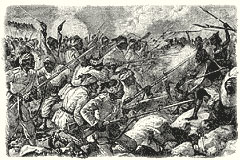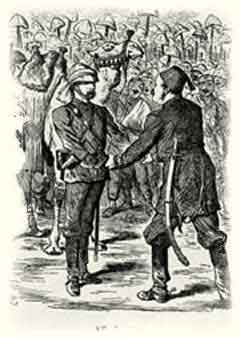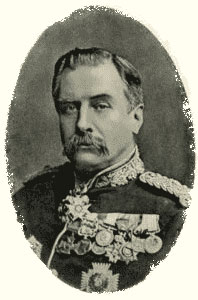
February 1884: “Graham Saves the Day”
The combined Anglo-Egyptian relief expedition, numbering approximately 7700 regulars and supported by another 800 native levies, and now under the command of General Wolseley advanced south from Wad Hamed following the banks of the Nile upstream towards Khartoum. On the 21st February, with their objective in sight on the far horizon, the army decamped from its defensive zeriba at dawn, intending to be at the city in time for tiffin.

Rough ground made it difficult to maintain the open square formation and the undulating terrain, rough vegetation and intermittent dust storms hindered visibility but good progress was made, even as Wolseley insisted on regular halts to reform the ranks. This proved to be fortuitous, as suddenly ‘fazands of native warriors broke from concealed positions, hurling themselves at the advancing columns. Despite some disorder in the ranks, the flanking British battalions were, without exception, able to wheel to face the enemy and begin disciplined close range volley fire into the serried ranks of their dusky foes.
Fierce hand to hand fighting erupted along the line, as the enemy closed; with the fearsome ‘devils in skirts’ proving particularly adept in dispatching the Ansar with bullet, bayonet and claymore. Elsewhere the British were rather less successful: The West Kents were overwhelmed after fierce fighting, with General Buller amongst the fatalities, the Yorks & Lancs wavered and the Royal Irish only just stood their ground despite immense pressure from overwhelming enemy numbers. During their desperate stand, General Wolseley and his staff had to throw themselves into the fray to save the Colours and in the ensuing melee Sir Garnet was thrown from his horse and critically wounded – it is not yet known if he will survive.
On the right, although the 4th Egyptian battalion broke and fled at first sight of the enemy, Baker handled his brigade well, protecting the flank of the KRRC. On the left, attempts to outflank the army by enemy cavalry and infantry were thwarted by coordinated fire from the ‘Fashoda’, assisted in part by long-distance fire from the walls of Khartoum.
Although a few hundred warriors broke into the square through the shattered remnants of the West Kents, they were adeptly despatched in a pincer movement coordinated by Graham, at the head of the XIIth Sudanese, and supported by a valiant charge of Egyptian cavalry led by Tewfiq Bey.

With well over half of the enemy lying in heaps around the British position by now, and several of their Emirs amongst the dead, the will of the Dervish army was broken and it was forced to withdraw from its positions around Khartoum, retreating into the desert to lick its wounds. Their casualties are estimated to be in excess of 8000 men. British and Egyptian casualties were no more than 400 men dead and seriously wounded (mainly from the West Kents) but a further 5-600 Egyptians are missing, presumed deserted. The loss of Redvers Buller is a particular blow, and we await further information on the prognosis for Sir Garnet.
It was therefore Gerald Graham that led the triumphant relief expedition through the gates of Khartoum, to be greeted by a prematurely aged, thin but still smiling Hicks Pasha. General Gordon was characteristically unreserved, embracing Graham in a bluff, manly, Christian way, and assuring him of his admiration (“you’re my best mate, you are”) and bursting into tears at the sight of Colonel Stewart. After what he has been through, even a hero like ‘Chinese’ Gordon has a right to be tired and emotional sometimes! It is not yet clear what his plans will be, but it is clear that he remains as determined as ever not to give up the city:
“I altogether decline the imputation that the expedition has come to relieve me. It has come to save our national honour, in extricating the garrisons, etcetera, from a position which our action in Egypt has placed these garrisons in. I was relief expedition number one. They are relief expedition number two. As for myself I could have made good my retreat at any moment I wished. Now realize what would happen if this first expedition was to bolt and the steamers fell into the hands of the Mahdi; this second relief expedition would be somewhat hampered.”
Despite the relief of the city, it is clear that the revolt remains a serious threat – word has reached us that Berber has surrendered to the enemy as the garrison’s supplies ran out, so the Northern District cannot yet be considered secure, and the rebels still hold sway throughout the southern and western Sudan. Debates in the House increasingly speak of ‘bringing our boys home’ and of replacing Gordon if he proves unwilling to fulfil his orders to evacuate all loyal Sudanese from Khartoum and withdraw the army.

March 1884: Onward Oh Brave Soldiers
Recognising the importance of keeping pressure on the disheartened Mahdists following their severe defeat outside Khartoum, General Graham has moved quickly to suppress the remaining rebel forces both north and south of the city.

Aware of growing political pressure to conclude this episode, he persuaded Governor Gordon to remain in Khartoum (arguing that, to leave at this point, even on a punitive expedition, might give the impression that the city was being abandoned to its fate and that the British were retreating).
Baker and Hicks were sent downstream with a brigade of Egyptians, supported by the ‘Fashoda’ and the Watusi levies (a force of approximately 3000 men) with orders to recapture Berber and Abu Hamed. At the time of writing, Berber has been recaptured, its improvised defences successfully stormed by the fellahin infantry despite the best efforts of some 2000 Jihadiyya to throw them back. In the fierce fighting almost 200 Egyptians (& an unaccounted number of levies) were killed or wounded. The enemy have withdrawn beyond the 5th cataract in disarray. Increasing numbers of local clan leaders have declared their renewed allegiance to British rule and it is expected that, but for a few die-hard fanatics to be swept aside, the liberation of Abu Hamed will now be only a matter of days.
To the south, Graham led a reinforced Anglo-Sudanese brigade (5000 men) upstream along the White Nile, with El Obeid (the centre of Mahdist resistance in the South West) his ultimate objective. 4000 Mahdists were driven from the field at El Dueim, despite being entrenched and supported by heavy artillery – British casualties were light (no more than 80 men, mainly from the Yorks & Lancs, incurred while storming the enemy position), although Tewfiq Bey was slightly wounded by rifle fire during the battle.
Stronger resistance was encountered three days later at Jebelein, when (what is assumed to be) the main Mahdist army in the region, including some units involved in the siege of Khartoum, attempted a surprise dawn attack on the British encampment. Luckily, the sentries were vigilant; the camp roused in time, and disciplined volley fire from the 7 battalions wrought fearful casualties on the attackers long before they reached the zeriba encircling the camp. Over 3000 bodies were counted on the field after the action, which lasted little more than 2 hours. British casualties were minimal. It should be noted that almost half of the enemy carried rifles (mainly captured Remingtons and Sniders) but preferred to charge to their deaths than engage the British square at long range. Graham now stands ready to advance on El Obeid, less than one week’s march across stony desert away from the river.
Elsewhere, General Stewart has disembarked at Suakin with two regiments of cavalry from India (800 men) and, seeking to gain some political capital now that victory seems inevitable, Mr. Gladstone authorized the release of further British reinforcements to the theatre. These troops (three infantry battalions, supported by artillery and a composite battalion of marines from the Mediterranean fleet, almost 3000 men under the command of Major General Sir John McNeill VC) have arrived at Wadi Halfa, ready for action.
One thought on “Fire & Sword in the Sudan: February-March 1884”